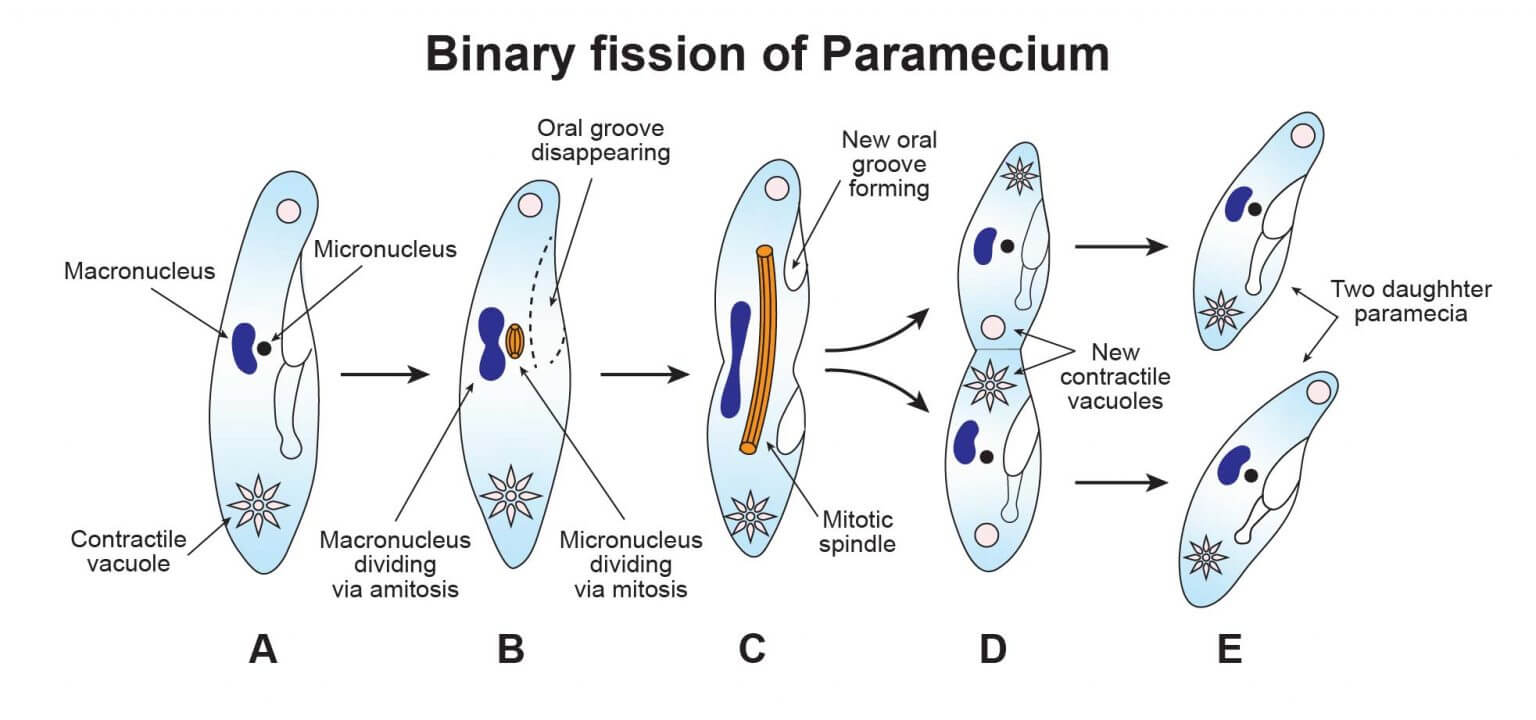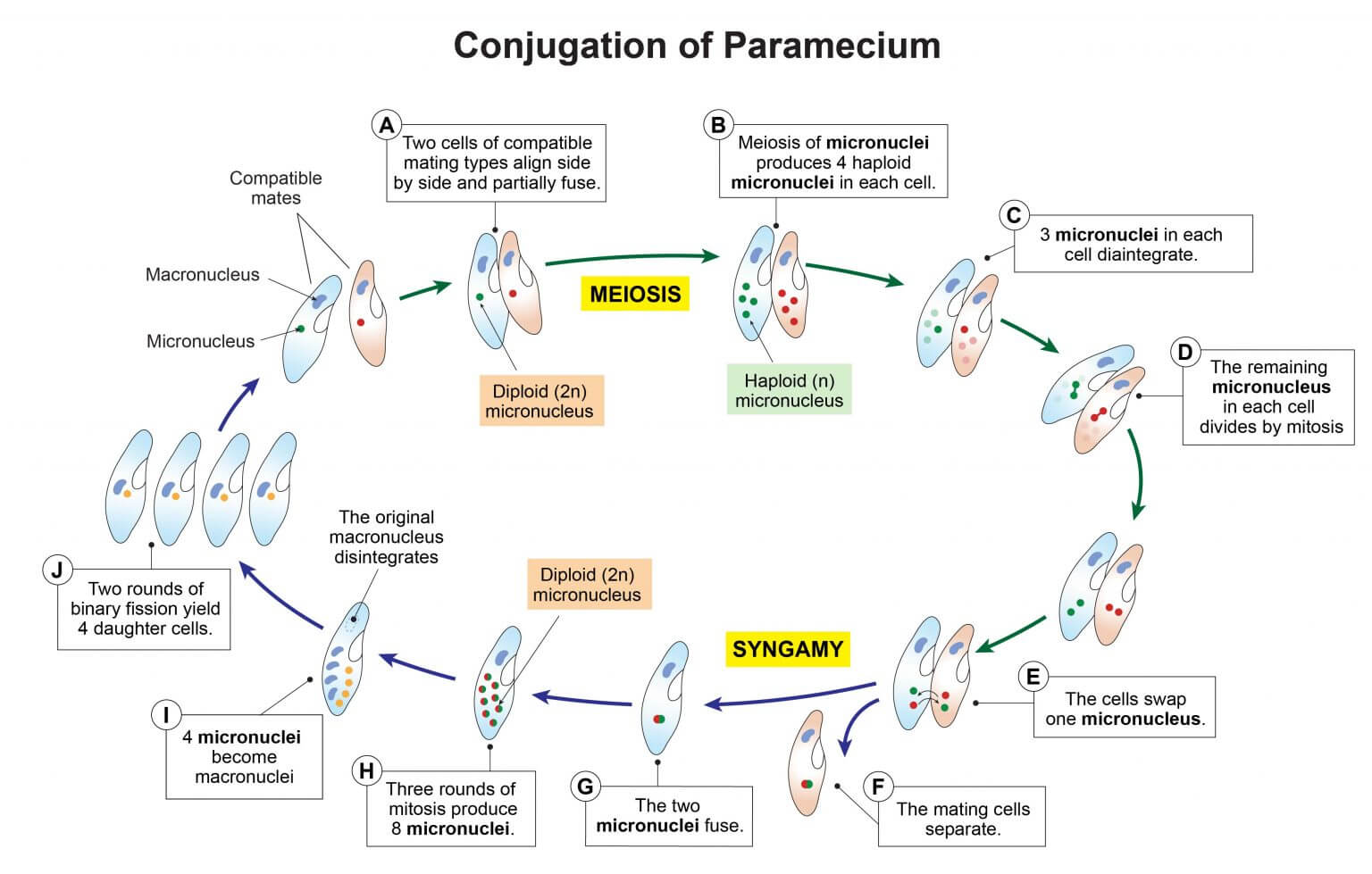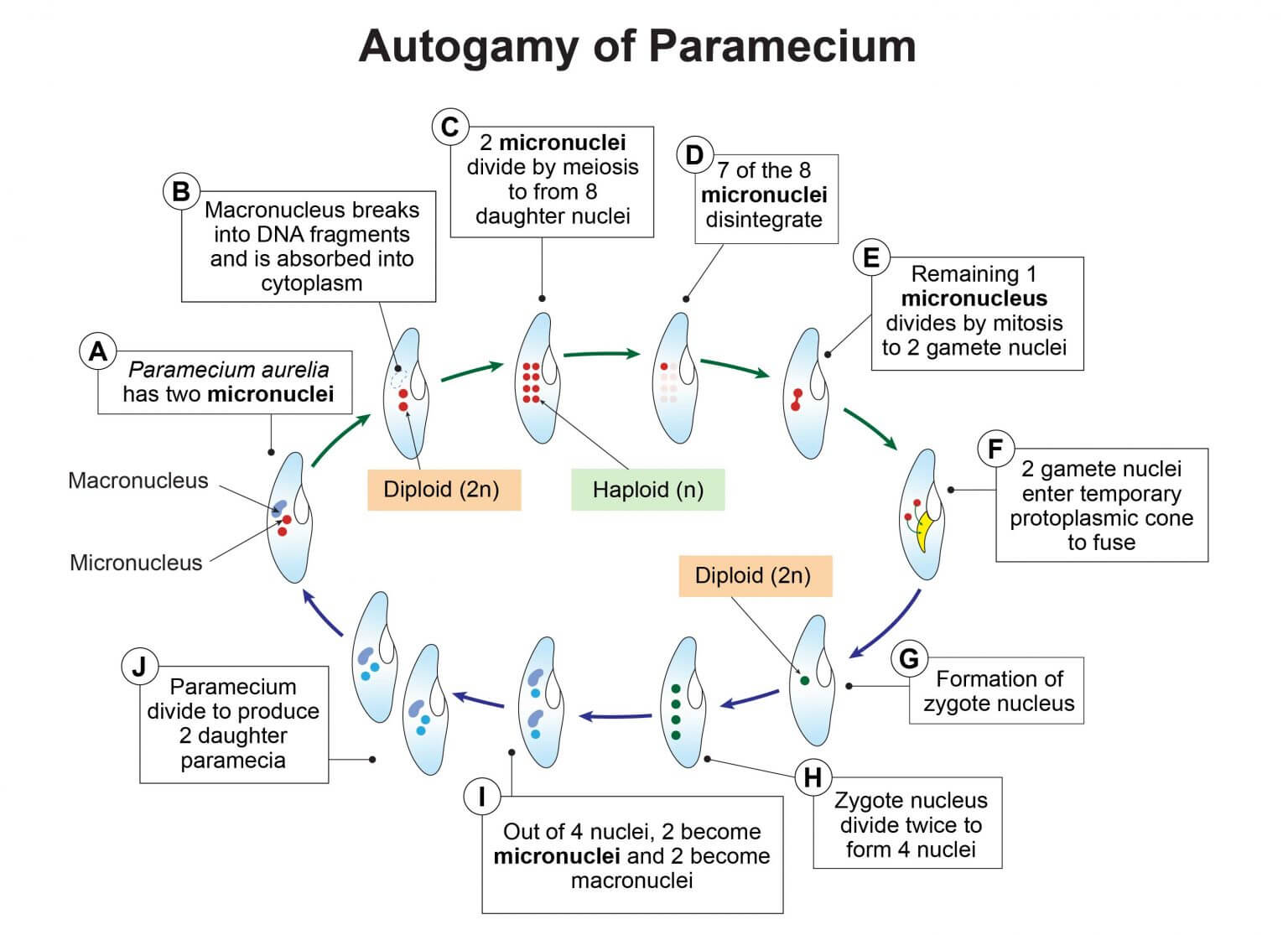
Parameciumreproduces asexually by transverse binary fission and also undergoes several types of nuclear reorganization, such as conjugation, endomixis, autogamy, cytogamy, and hemixis, etc.
1. Transverse binary fission (Asexual reproduction)
- This is the commonest type of Asexual reproduction inParamecium.
- It occurs during the favorable condition when food is available in large quantities and the temperature is favorable.
- It is a unique asexual process in which one fully grown specimen divides into 2 daughter individuals without leaving the parental corpse.
- The division is at the right angle to the longitudinal axis of the body.
- The division of the whole-cell body as a whole is always preceded by the division of nuclei; indeed, it appears that reproduction is initiated by nuclear activity and division.
- In this process, themicronucleusstarts dividing by the complicated process ofmitosisinto 2 daughter micronuclei which move in opposite ends of the cell.
- Simultaneously, themacronucleusdivides transverselyamitoticallyby simply becoming elongated and constricted in the middle.
- 2 oral grooves now begin to form, one in the anterior half and the other in the posterior half.
- 2 original contractile vacuoles remain one in each half of dividing parental individuals.
- 2 new contractile vacuoles are later formed and also 2 new buccal structures appear.
- In meantime, constriction furrows appear near the middle of the body.
- Constriction furrows deepen and ultimately the cytoplasm is completely divided, resulting in twodaughterParameciaof equal size, each containing sets of cell organelles.
- Of the 2 daughters, paramecia the anterior one daughter paramecia calledproterand the posterior,opisthe.
- These grow to full size and again divide occurs by fission.
- By binary fission,Parameciumcaudatumdivides 2-3 times in a day.
- The process of binary fission requires 2 hours to complete.
- About 600 generations are produced in a year by binary fission.
- The rate of multiplication depends upon external conditions of food, temperature, age of culture, and population density; also, on the internal factors of heredity and physiology.
- All individuals that are produced from one parent paramecium is called a clone.
- All the members of the clone are genetically alike.

Figure: Binary fission of paramecium. Paramecium reproduces asexually by binary fission during favorable conditions in the following steps:(A)Paramecium stops feeding and starts to replicate its DNA,(B)Oral groove disappears. The micronucleus forms the mitotic spindle and starts the mitotic division. The macronucleus changes its shape and starts the amitotic division.(C)Both mitosis and amitosis continue to split into two daughter micronuclei and macronuclei. New oral grooves form as the cell becomes elongated.(D)The endoplasm is divided into two in the middle of the cell transversely. The anterior portion is known as proter and the posterior portion is known as opishte. The proter and opisthe portions are just like that of their parents in size, shape, and structure.(E)The whole process completes. All such individuals which are formed from a single parent are known as a clone. One binary fission needs twenty minutes and in 24 hours it divides two or three times. Image Source:Rs’ Science.
2. Conjugation (sexual reproduction)
- Frequently referred to as sexual reproduction.
- It is simply the temporary union of 2 individuals who mutually exchanging part of their micronuclear materials.
- It is a unique process in which 2 individuals separates soon after the exchange of their nuclear materials.
- This process in paramecium occurs frequently between binary fission and is necessary for the continued vitality of the species.

Figure: Steps of paramecium’s conjugation. Image Source:Rs’ Science.
Process of conjugation
- It differs slightly in different species of paramecium. The following is related toP.caudatum.
- In conjugation (sexual reproduction) the two paramaecia orpreconjugatesfrom 2 different mating types of the same variety come in contact ventrally and unite through the edges of their oral groove.
- Their cilia produce a substance on the surface of the body which causes the adhesion of 2 conjugating paramecia.
- They then stop feeding and their buccal structure disappears.
- The pellicle and ectoplasm, all along with the union of two forms, are disintegrated and aprotoplasmic bridgeis formed between 2 individuals.
- Now, at this stage, they are called gametocytes or conjugant.
- 积极接合一对继续游泳,nd a series of nuclear changes take place in each conjugant.
- The macronucleus simply breaks up into fragments, which are later absorbed by the cytoplasm.
- 和二倍体微米ucleus of each conjugant first grows in size and divides by meiosis.
- And forms 4 haploid daughter micronuclei.
- Out of these four micronuclei, three daughter micronuclei disintegrate or become pyknotic and disappear in each conjugant, while the remaining one divides into two unequal daughterpronucleiorgamete nuclei.
- Of these, the smaller one is the activemalemigratory pro-nucleus, whereas the larger one is thestationary female pro-nucleus.
- The migratory male pro-nucleus of each conjugant moves through the protoplasmic bridge into the other conjugant and ultimately fuses with stationary female pro-nucleus forming azygote nucleusorsynkaryonin which the diploid number of chromosomes is restored and there has been exchanged of hereditary material.
- The nucleus of the zygote is diploid and is calledamphinucleus and this type of mixing of two nuclei from different individuals is called amphimixis.
- The 2pairing paramecia, after a union of 12 to 48 hrs. separate and now calledexconjugants.
- In each exconjugants, the zygote nucleus divides by mitosis 3 times in rapid succession producing 8 micronuclei, of which 4 enlarge to becomemacronucleiand 4 to become
- 3 micronuclei disintegrate and disappear.
- while remaining micronucleus divides with binary fission of exconjugants.
- Now, from each conjugant 2 daughters, paramecia are obtained, each containing 2 macronuclei and 1 micronucleus.
- The micronucleus again divides with the division of each daughter paramecium, forming 2 individuals each containing one macronucleus and one micronucleus.
- At the end conjugation, 4 daughter individuals are produced from each conjugant.
Factor and condition of conjugation
Conjugation is very complex physiologically. The factor inducing conjugation varies from species to species. some of them are:
- Occurs under an unfavorable condition like starvation or shortage of food and particular bacterial diet or certain chemicals.
- Sudden darkness in light conditions and low temperature differing with species is said to essential for conjugation.
- Occurs when there is a change in the physiological condition of paramecia, it occurs between such individuals which are smaller in size (210 µm long) than the normal individuals (300-350 µm long).
- Conjugation occurs after about 300 asexual generations of binary fission, or it alternates with binary fission at long intervals to rejuvenate the dying clone.
- Conjugation usually starts early morning and continued till afternoon. It does not take place during the night or darkness.
- The pairing conjugants areisogamousand there is no morphological sexual dimorphism into male and female conjugants.
- 结合个人之间只发生ing to different mating types. It never takes place among the members of a ‘pure line’, that is among the descendants of a single individual.
- A proteinaceous substance in the cilia of mating-type individuals is said to induce conjugation.
Significance of conjugation
A clone will die out if nuclear reorganization does not occur, but the clone can be rejuvenated to regain its former vigor by nuclear arrangement, this is brought about by conjugation. Thus, conjugation is essential for continued binary fission. The significance of conjugation is described below:
- If binary fission continues repeatedly for a longer period of time,Parameciumloses its vigor and physiologically depressed, reduces in size, ceases to multiply, degenerates in the organization, and eventually die. So, to avoid this senile decay of race, conjugation serves as a process ofrejuvenationorreorganizationby which the vitality of race is restored. However,WoodruffandJenningsdo not support the view that conjugation helps in rejuvenescence. Woodruff claim of keeping paramecium healthy for 22,000 generations without conjugation.
- There is no distinction of sex in conjugation though only paramecia of different mating types of the same variety will conjugate.
- There is no distinction of sex, yet the active migratory pronucleus is regarded as male and the stationary pronucleus are regarded as female.
- Conjugation ensures theinherited variation.It brings about the blending of 2 lines of ancestry just as bisexual reproduction does but in asexual reproduction, the hereditary material of the parent passes unchanged on to the progeny. So, allparameciumhas the same inheritance.
- Conjugation brings about thereplacement of the macronucleuswith material from the zygote nucleus, this is an event of fundamental importance.
- Conjugation brings about theformation of the correct number ofchromosomein the macronucleus, so the race is renewed in vigor and vitality to accelerate the metabolic activities but in binary fission chromosome of the macronucleus were distributed at random to the daughter cell, continued binary fission had made the clone weak with some structural abnormalities.
3. Autogamy

Figure: Steps of autogamy of Paramecium aurelia. Image Source:Rs’ Science.
Process of Autogamy
- F. Diller (1936)described a process ofself–fertilizationorautogamyoccurring in a single individual inparameciumaurelia.
- He reported that during autogamy, the 2 diploid micronuclei divide by meiosis to form 8 haploid daughter nuclei.
- Out of 8, 7 disintegrated, while the remaining haploid micronucleus undergoes amitotic division forming 2 gamete nuclei.
- Meanwhile, the macronucleus grows into a skin-like mass which breaks into pieces later to be absorbed in the cytoplasm.
- The 2 gamete nuclei enter a protoplasmic cone bulging near the cell mouth.
- Then two pronuclei fuse together to form a completely homozygous diploidzygote nucleusorsynkaryon.
- The zygote nucleus gain divided to form 4 micronuclei. 2 become micronuclei and 2 become macronuclei.
- 胞体。parameciumand its micronuclei divide to form 2 daughter individuals, each with 1 macronucleus and 2 micronuclei.
- The process is completed in 2 days.
- Autogamy rejuvenatesParamecium.
- Autogamy differs from conjugation because only one individual takes place in autogamy and it provides both the pronuclei, it is a kind ofself-fertilization.
4. Cytogamy
- Wichterman (1940)reported another sexual process in P.caudatum, which he termed ascytogamy.
- There is no nuclear exchange in cytogamy.
- This process resembles conjugation in that 2 small paramecia (200µlong) temporarily fuse by their oral surface, but the pellicle of the 2 individuals does not break down.
- The early nuclear division are similar to those of conjugation, but there is no nuclear exchange between the individuals (Cytogamonts).
- The micronucleus of each individual divides thrice to form 8 micronuclei, 6 of which disintegrate in each individual.
- The 2 remaining micronuclei fuse to form a synkaryon in each cell.
- Then the animals now separate.
- The process is completed in about 13 hours.
- Cytogamy differs from autogamy in that there are 2 animals in contact with each other but resembles autogamy and conjugation in the fusion of 2 pronuclei.
5. Endomixis
- Woodruff and Erdmann(1914) first reportedendomixisin the bimicronuclaete species,P.aurelia.
- Endomixis (Gr.,endon,within +mixis, mingling) is an interesting phenomenon occurring periodically in which a new macronuclear apparatus is produced without synkaryon formation.
- It occurs within single individuals.
- In the process, the vegetative macronucleus degenerates and disappears.
- While the micronuclei divide twice by mitosis forming 8 daughter nuclei of which 6 degenerates.
- At this stage, animals divide by fission into 2 cells, each with one micronucleus.
References and Sources
- Kotpal RL. 2017. Modern Text Book of Zoology- Invertebrates. 11th Edition. Rastogi Publications.
- Jordan EL and Verma PS. 2018. Invertebrate Zoology. 14th Edition. S Chand Publishing.
- 3% – https://www.biologydiscussion.com/invertebrate-zoology/protozoa/paramecium-caudatum-habitat-structure-and-locomotion/28315
- 3% – https://www.biologydiscussion.com/invertebrate-zoology/protozoa/reproduction-in-paramecium-zoology/60260
- 3% – https://acsw.dypvp.edu.in/documents/Study-Material/Zoology/Study-of-paramecium.pdf
- 2% – https://tacs.dypvp.edu.in/documents/Study-Material/Zoology/Study-of-paramecium.pdf
- 2% – https://androbose.in/paramecium-caudatum-habitat-structure-and-locomotion/
- 1% – https://www.studyandscore.com/studymaterial-detail/paramecium-sexual-reproduction-and-asexual-reproduction
- 1% – https://www.shareyouressays.com/knowledge/five-important-types-of-reproduction-in-paramecium/92348
- 1% – https://www.notesonzoology.com/protozoa/paramecium-protozoa/how-do-paramecium-reproduce-protozoa-microorganisms-zoology/9168
- 1% – https://vijjay-gm.blogspot.com/
- 1% – https://onlinesciencenotes.com/asexual-and-sexual-reproduction-in-paramecium/
- <1% – https://www.studyandscore.com/studymaterial-detail.php?Id=paramecium-sexual-reproduction-and-asexual-reproduction
- <1% – https://www.ncbi.nlm.nih.gov/pmc/articles/PMC3321029/
- <1% – https://www.britannica.com/science/binary-fission
- <1% – https://www.bbc.co.uk/bitesize/clips/zywc87h
- <1% – https://quizlet.com/106804002/asexual-reproduction-flash-cards/
- <1% – https://courses.lumenlearning.com/biology1/chapter/the-cell-cycle/
- <1% – http://www.shareyouressays.com/knowledge/five-important-types-of-reproduction-in-paramecium/92348
- <1% – http://irrec.ifas.ufl.edu/postharvest/HOS_5085C/Reading%20Assignments/Wills-8-%20Physiological%20Disorders.pdf

